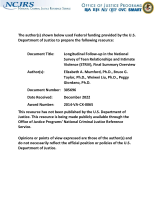Young adults (18-24)
NIJ FY23 National Study Examining Interpersonal Violence Experienced By Young Adults
Testing the Factor Structure and Measurement Invariance of the Conflict in Adolescent Dating Relationship Inventory
Longitudinal Follow-up in the National Survey of Teen Relationships and Intimate Violence (STRiV), Final Summary Overview
Romantic Relationship Characteristics and Adolescent Relationship Abuse in a Probability-Based Sample of Youth
Young Men's Attitudes and Neighborhood Risk Factors for Sexual Harassment Perpetration in the United States
Relationship Dynamics and Abusive Interactions in a National Sample of Youth and Young Adults
Daily Reports of Aggressive Behaviors in Interpersonal Conflicts
Correlates of the victim–offender overlap based on daily conflict-Level data from digital diaries
Longitudinal Follow-up in the National Survey of Teen Relationships and Intimate Violence (STRiV)
Tribal Crime, Justice, and Safety
Tribal Crime, Justice, and Safety, Part 1
Research indicates that Native American persons experience crime victimization at higher rates than non-Native people. Furthermore, the unique position of American Indian and Alaska Native tribes as both sovereign nations and domestic dependents of the U.S. creates jurisdictional complexities in responding to crime, justice, and safety. Senior social and behavioral scientist Christine (Tina) Crossland discusses NIJ’s research on these topics, especially on the prevention of violence towards American Indians and Alaska Natives. Communications Assistant Stacy Lee Reynolds hosts.
The Association Between PTSD Symptoms and IPV Perpetration Across 6 Years
Project on Human Development in Chicago Neighborhoods
From Successful Reentry to Stronger Communities
FY22 OJP Community Based Violence Intervention & Prevention Initiative (CVIPI) & NIJ Evaluation of CVIPI Projects









